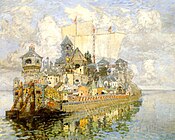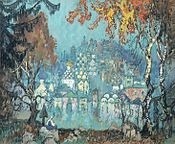Konstantin Gorbatov
- Machine translation, like DeepL or Google Translate, is a useful starting point for translations, but translators must revise errors as necessary and confirm that the translation is accurate, rather than simply copy-pasting machine-translated text into the English Wikipedia.
- Do not translate text that appears unreliable or low-quality. If possible, verify the text with references provided in the foreign-language article.
- You must provide copyright attribution in the edit summary accompanying your translation by providing an interlanguage link to the source of your translation. A model attribution edit summary is
Content in this edit is translated from the existing Russian Wikipedia article at [[:ru:Горбатов, Константин Иванович]]; see its history for attribution. - You may also add the template
{{Translated|ru|Горбатов, Константин Иванович}}to the talk page. - For more guidance, see Wikipedia:Translation.

Konstantin Ivanovich Gorbatov (Russian: Константин Иванович Горбатов; 17 May [O.S. 5 May] 1876 – 24 May 1945) was a Russian post-impressionist painter.[1]
Biography
Gorbatov was born in Stavropol in the Samara province. He lived in Riga from 1896 to 1903, and studied civil engineering before painting. Gorbatov moved to St. Petersburg in 1904 and studied at the Baron Stieglitz Central School for Technical Draftsmanship. He initially entered the architecture department of the Imperial Academy of Arts before switching to painting that he studied under Nikolay Nikanorovich Dubovskoy. Gorbatov received a scholarship and studied art in Rome and Capri. He returned to St. Petersburg and participated in the Peredvizhniki exhibitions.[2]
Gorbatov left Russia permanently in 1922 following the Russian Revolution of 1917 and settled on the Italian island of Capri. He moved to Berlin in 1926, where he remained until his death. Gorbatov became a member of a Russian emgiree artistic circle that included Leonid Pasternak, Vadim Falileyev, Ivan Myasoyedov. He became a well-known established artist. Gorbatov traveled throughout Europe during the late 1930s, visited Palestine and Syria in 1934 and 1935, and often came by Italy. Gorbatov's art became unneeded in Nazi Germany and the family soon became impoverished. As a Russian émigré, he was forbidden to leave Germany during World War II. Gorbatov died shortly after the allied victory over Germany on 12 May 1945. His wife committed suicide on 17 June 1945.[2]
Gorbatov bequeathed to the Academy of Arts in Leningrad. The works were delivered to the Moscow Regional Museum of history and Arts near the New Jerusalem Monastery, where they have since been exhibited.[2]
Selected works
-
 View of an Old Town
View of an Old Town -
 Kitezh, 1913
Kitezh, 1913 -
 The Drowned City, 1933
The Drowned City, 1933
References
- ^ Gorbatov, Konstantin Ivanovich (in Russian)
- ^ a b c Biography and works of Gorbatov (in Russian)
External links
 Media related to Konstantin Gorbatov at Wikimedia Commons
Media related to Konstantin Gorbatov at Wikimedia Commons
- v
- t
- e














